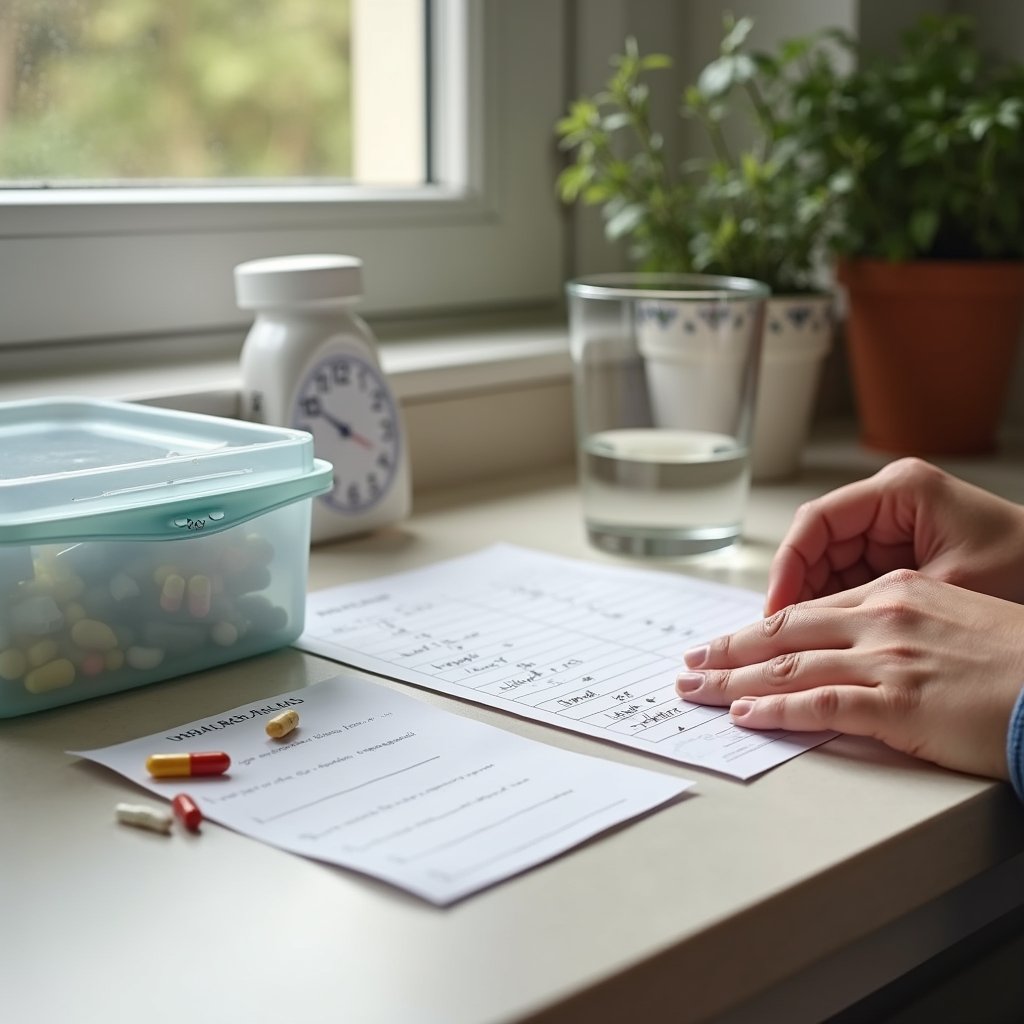Supporting a loved one through Suboxone treatment requires your active involvement in their recovery endeavor. You’ll need to create a structured home environment with consistent routines, secure medication storage, and trigger-free spaces. Focus on maintaining open communication while respecting boundaries, and help establish regular schedules for therapy and medication. Combine your emotional support with practical strategies like family therapy and lifestyle modifications. Understanding the complete recovery process will strengthen your ability to provide effective support.
Understanding the Role of Suboxone in Recovery

How does Suboxone work to support recovery from opioid use disorder? This medication combines two key components buprenorphine and naloxone that work together to help your loved one overcome addiction safely. Buprenorphine partially activates opioid receptors, reducing cravings and withdrawal symptoms, while naloxone prevents misuse. Studies show that long-term outcomes are generally better with Suboxone than attempting to stop opioid use completely.
The treatment effectiveness of Suboxone stems from its unique pharmacological profile. It’s powerful enough to manage withdrawal but includes built-in safety considerations through its ceiling effect, which considerably reduces overdose risk. As a medication that is 20-50 times stronger than morphine at analgesic doses, Suboxone must be carefully prescribed and monitored. The medication’s slow dissociation rate from opioid receptors ensures a longer-lasting therapeutic effect. You’ll find that Suboxone offers distinct advantages over other treatments because it can be taken at home, requires less frequent dosing, and maintains a strong safety profile when used as prescribed.
When combined with counseling, it helps many people achieve lasting recovery while allowing them to maintain their daily responsibilities.
Building a Strong Support Network at Home

Creating a recovery-supportive home environment starts with establishing dedicated substance-free spaces and consistent daily routines that provide structure and predictability.
You’ll find that maintaining regular meal times, therapy appointments, and medication schedules helps reduce stress while strengthening your commitment to treatment. Research shows that ongoing medication use plays a vital role in managing symptoms and cravings beyond the first year of recovery. Family involvement across the continuum of treatment services has been shown to increase engagement and create more supportive environments for recovery.
Your living space should serve as a sanctuary where you can focus on healing, complete with designated areas for relaxation, family activities, and open communication about your recovery path.
Creating Safe Recovery Spaces
Establishing a secure and supportive home environment marks a crucial step in your Suboxone treatment expedition. Start by creating calming sensory environments through designated private treatment areas and phone-free zones that minimize distractions during therapy sessions.
When establishing sober living guidelines, focus on securing medications properly and removing any substance-related items that could trigger cravings. Through telemedicine services, you can maintain consistent treatment from the comfort and privacy of your home. Our team knows slip-ups happen during recovery, so we maintain a non-judgmental approach to support your journey. Leveraging our behavioral therapy sessions helps identify and address underlying issues driving addiction.
Transform your space by incorporating physical activity areas and mindfulness zones to help manage stress and reduce cravings. You’ll want to keep emergency supplies like naloxone kits readily accessible while ensuring they’re stored safely.
Consider using SAMHSA’s treatment locator to identify nearby providers and create a resource map for quick access to support. Remember to conduct regular home audits to identify and eliminate potential triggers in your recovery space.
Daily Routines Matter Most
While medication management forms the cornerstone of Suboxone treatment, your daily routines and support network at home will profoundly impact your recovery success. Establishing consistent medication reminders and household schedules creates a foundation for sustainable recovery. Active listening from family members provides essential emotional validation during challenging moments.
Start by integrating structured dosing times into your family’s daily rhythm, using visual aids or smartphone apps to track administration. Distribute recovery-related responsibilities among family members, from transportation to therapy appointments to maintaining a recovery-friendly environment. Set regular check-in times to discuss challenges and celebrate progress. Since studies show opioid use patterns may fluctuate during initial months of treatment, maintaining consistent family support is crucial.
Your home routine should include dedicated time for therapy reinforcement, stress management, and family education about MAT. Incorporating cognitive behavioral therapy techniques into daily interactions helps family members support positive behavioral changes. Remember to balance support activities with personal boundaries, allowing each family member to maintain their well-being while contributing to your recovery pathway.
Creating Safe Medication Management Practices

Safe medication management forms the cornerstone of successful Suboxone treatment, requiring careful attention to both daily routines and security measures. When supporting your loved one, focus on ensuring proper dosage administration by tracking daily doses and following prescribed timing to prevent withdrawal symptoms. Consider implementing low-threshold approaches to make the treatment process more manageable for your family member.
Establish clear medication storage protocols by keeping Suboxone in a locked container away from children and others. You’ll need to help monitor that tablets or films are placed under the tongue until fully dissolved never crushed or chewed. It’s essential to reinforce that sharing medication isn’t just dangerous but illegal.
Watch for and report any side effects like dizziness or concentration issues to the healthcare provider. Keep naloxone kits accessible, and help maintain distance from alcohol and other opioids to prevent dangerous interactions.
Navigating Emotional Challenges Together
Supporting a loved one through Suboxone treatment requires traversing complex emotional terrain together. By identifying emotional triggers and sustaining motivation and hope, you’ll create a foundation for lasting recovery. Your consistent presence and understanding can make a a great impact in their healing trek.
Create a judgment-free environment where they can openly discuss cravings, fears, and setbacks without shame. Monitor changes in their mental health and mood patterns to enable quick intervention when needed. Participate actively in family therapy sessions to strengthen communication and rebuild trust. Celebrate small victories and milestones to reinforce positive behaviors and combat isolation. Incorporating evidence-based therapies like CBT and DBT can provide additional tools for managing emotional challenges during recovery.
Remember to maintain healthy boundaries while showing support, and connect them with peer support groups to expand their recovery community. Your patience and dedication contribute immensely to their emotional stability during treatment.
Accessing Professional Resources and Treatment
Accessing professional treatment resources marks a crucial step in the Suboxone recovery expedition. You’ll find evidence-based programs through SAMHSA’s 24/7 helpline and treatment program guidance via specialized toolkits. Emergency departments now offer immediate support for starting Suboxone treatment, connecting you with qualified providers and support teams. Families can access clinician-to-clinician consultation services Monday through Friday from 6 AM to 5 PM Pacific Time for expert substance use guidance. Free educational materials are available to help patients and families understand medication-assisted treatment options.
| Resource Type | What You’ll Find |
|---|---|
| National Helplines | 24/7 confidential support in English/Spanish |
| Provider Locators | State-authorized Suboxone prescribers |
| Emergency Care | Same-day treatment initiation |
| Support Teams | Counselors and medical specialists |
| Online Tools | Educational materials and FAQs |
Maintaining Long-Term Recovery Success
While starting Suboxone treatment marks a substantial milestone, maintaining long-term recovery requires dedicated commitment and proven strategies. Research shows that extended treatment combined with counseling drastically improves success rates and reduces health risks by up to 173%.
To sustain your recovery pathway, focus on these essential elements:
- Maintain consistent medication schedules and attend all follow-up appointments to optimize your treatment plan
- Integrate counseling sessions to strengthen coping mechanisms while fostering family bonding
- Balance work life responsibilities with recovery needs through professional support and lifestyle adjustments
- Stay connected with your treatment team to address challenges early and prevent relapse
Frequently Asked Questions
How Long Does It Take for Suboxone to Start Working?
You’ll typically feel Suboxone’s initial effects within 20-60 minutes after taking it, with peak potency occurring between 1.5-3 hours. The medication actively works to reduce withdrawal symptoms throughout the foremost 24 hours.
Keep in mind that everyone responds differently, and your doctor may need to make dosage adjustments to find your ideal level. For best outcomes, you should only take Suboxone when you’re experiencing active withdrawal symptoms.
Can Someone Work or Drive While Taking Suboxone?
Yes, you can typically work and drive while taking Suboxone when properly prescribed and managed. Workplace policy considerations vary by employer, particularly for safety-sensitive positions, but the Americans with Disabilities Act often protects your right to work while on treatment.
As for driving, studies show that stable, long-term Suboxone use presents minimal impaired driving risks. However, you’ll need to monitor how the medication affects you and always follow your healthcare provider’s guidance.
What Happens if a Dose of Suboxone Is Accidentally Skipped?
If you accidentally skip one dose of Suboxone, don’t panic. Due to the medication’s long-acting properties, you likely won’t experience withdrawal symptoms from a single missed dose.
If you realize you’ve missed a dose and it’s not close to your next scheduled time, you can take it when you remember. However, if it’s nearly time for your next dose, just resume your regular schedule.
Always guarantee medication availability to prevent future missed doses.
Will Insurance Cover the Cost of Suboxone Treatment?
Most insurance plans will cover Suboxone treatment, but coverage details vary. You’ll need to check your specific plan’s formulary and work with an in-network provider to keep costs manageable.
Medicare, Medicaid, and private insurers typically offer coverage with prior authorization. If you’re concerned about costs, there are affordable treatment options available, including generic versions and manufacturer discount programs.
Contact your insurance provider directly to understand your exact coverage and copay requirements.
Can Someone Become Addicted to Suboxone Itself?
Yes, you can develop physical dependence on Suboxone, even when taking it as prescribed. While it’s safer than full opioids, there’s still a cross addiction potential. You’ll likely experience withdrawal symptoms if you stop suddenly.
However, when you follow your doctor’s prescribed dosing and supervision, these risks are manageable. The key is working with your healthcare provider to eventually taper off slowly and safely when you’re ready.

